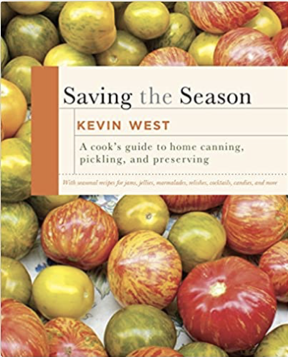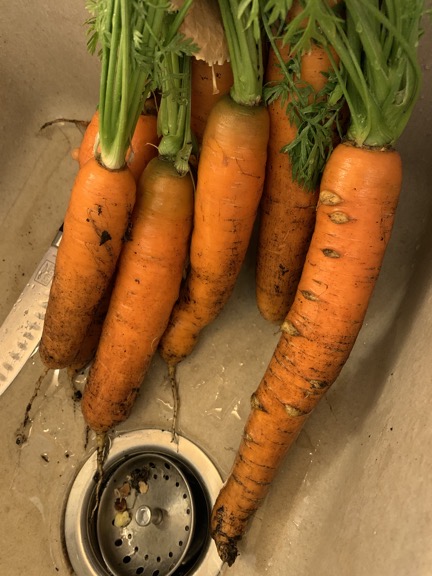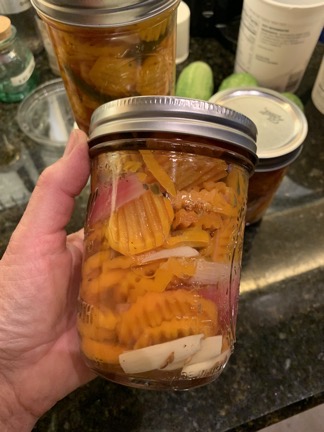I start canning. Again.

Saving the Season is just the book I needed to come up with creative ways to store what I harvest.
My garden is neither small nor large. It would probably be just right for a family of four.
I am a family of one.
While it’s wonderful to be able to pull 75% of the food I consume right out of my own garden, it’s horrible to harvest far more food than I can possibly eat or give away. After all, my friends and neighbors have gardens, too. Although mine was a bit earlier than most, they’re all caught up and trying to give me zucchini, tomatoes, etc. Needless to say, my chickens are feasting on soft tomatoes, peppers, zucchini, and other things these days.
Canning Tomatoes
Last year, I had what I thought was a pretty good crop of roma tomatoes. I set about canning them with my boiling water bath setup, which, because I have a glass-top stove, must be done on the burner beside my BBQ grill out on the deck.
Canning tomatoes is not fun. First you have to boil the jars and lids to sterilize them. Then you have to wash the tomatoes, remove the skins by scalding them in boiling water, dropping them into ice water, and sliding the skins off. Then chop them. Then put them in the prepped jars with a tablespoon of lemon juice to add acid. Then boil them for the required time in the canning setup.
It took me two hours to can two pints of tomatoes last year. I swore I’d never do it again. After all, what does a can of tomatoes cost at the supermarket? Why am I wasting my time canning mine?
Trying Again with Carrots
A few years ago, I’d bought a book at a bookstore up in Winthrop called Saving the Season. It’s all about canning and preserving what comes out of your garden. This year, I finally opened it when I was ready to “save” something I was taking out of my garden: carrots.
Yes, I grew carrots this year for the first time. I cannot believe how well they grew — even in my raised beds, which are only one foot deep! And as one batch was getting big, I planted another batch.

After pulling one or two carrots a week, I finally pulled the rest of the entire first batch. They were huge.
I soon discovered two things:
- Carrots keep getting bigger if you don’t harvest them.
- Freshly harvested carrots lose their stiffness quickly after harvesting. (I won’t tell you what they remind me of after just a few days in the fridge.)
I realized that I’d have to harvest them before the next batch was ready and use them as quickly as I could. Harvesting was easy. Just pull them out from their tops. I had a bunch of really large ones to work with. (Although I only want the orange part, my chickens really seem to love the green tops.) Unfortunately, I just didn’t feel like eating carrots.
The answer was to pickle and can them. The recipe I chose was “Picked Carrots, Taquería Style.” This would produce carrots like those that can sometimes be found at a real Mexican restaurant’s salsa bar. The best part of this recipe: not only would it use up all the carrots I’d picked, but it also called for red onions, jalapeño peppers, and garlic, all of which I also harvested from my garden.

One of my four pint-sized jars of Mexican pickled carrots.
So I put aside memories of peeling tomatoes and got to work following the recipe, dragging my canning setup out of storage in the garage, and prepping the four pint jars I’d need for canning. It went remarkably well, even though I never got the canner up to a full rolling boil. (The recipe said 30 minutes at 180° to 185° was fine.) Although my kitchen looked as if I’d just cooked for a party of 10 when I was done, I had four beautiful jars of pickled carrots that I could store in my pantry until I was ready to eat them.
I also had about a half cup of carrots with some liquid leftover. I put those in a jar in the fridge. This morning, I opened it up for a taste — I knew I wouldn’t like them hot so I didn’t taste them while I was making them. They were delicious.
Now I’m looking forward to that second batch of carrots to be ready to pull. I want to make another four jars to take me through the winter.
And beets….do I have a recipe for those? Let’s see….



